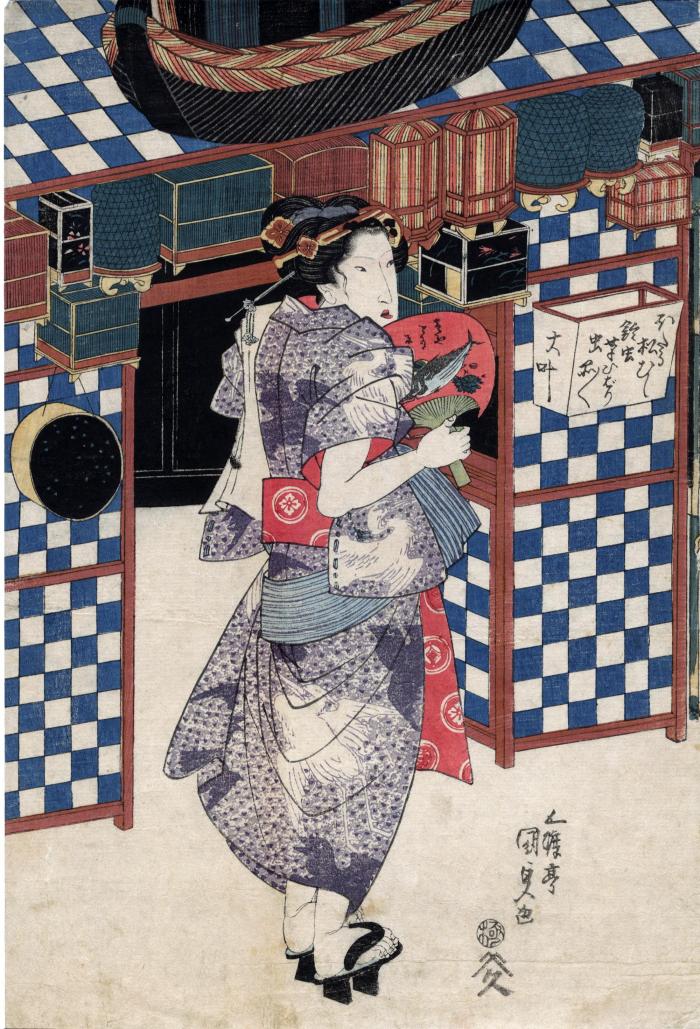Utagawa Kunisada (歌川国貞) / Toyokuni III (三代豊国) (artist 1786 – 01/12/1865)
Bijin in a summer robe, standing before an insect merchant's portable booth, visiting a shrine temple during a festival - this is the left panel of a triptych entitled En'nichi no kei (ゑん日乃景) in the toshidama cartouche in the center panel
1820s
10 in x 14.75 in (Overall dimensions) Japanese woodblock print
Signed: Gototei Kunisada ga
五渡亭国貞画
Publisher: Yamamotoya Heikichi
(Marks 595 - seal 04-007)
Censor's seal: kiwame
Museum für angewandte Kunst, Vienna
Tokyo Metropolitan Library - the whole triptych
National Diet Library - go to #54
Omiya Bonsai Museum - the whole triptych
Hankyu Culture Foundation - Similar Hokuei print from 1832
Nationaal Museum van Wereldculturen (Rijksmuseum Volkenkunde, Leiden) via Ritsumeikan University
Berkeley Art Museum and Pacific Film Archive at the University of California
Victoria and Albert Museum Merchants stalls were set up outside of shrines and temples often during festival days. We know that it is summer because the woman with the child in the right-hand panel of the full triptych appears to have just come from a bathhouse because she is wearing a light robe with a tenugui or hand towel over her shoulder. They are standing in front of a display of plants which are being offered for sale. We know that it is nighttime, or almost so, because the woman in the center panel is accompanied by a male servant who is carrying a lantern with a toshidama motif decorating or identifying it. Their panel is populated by a goldfish merchants display. The woman in the Lyon Collection panel on the left features the different insects being sold. The name of the merchant or shop is 'Okane'.
The fan the woman is holding looks very much like it is decorated with a Hiroshige fish print. Also, as best we can tell the writing on the box attached to the vendor's blue and white checkered booth says something like: "Various different insects are sold in cages." Or they might be advertising the types of insects they are selling: ほたる (hotaru/fireflies)、松むし(matsu mushi/pine bugs)、鈴虫 (tsuzumushi/bell crickets)、草ひばり (kusahibari/grass crickets)、虫品々 (and various other insects).
****
The Google translation from the Omiya Bonsai Museum of Art describes the whole composition: "A scene of a fair on a summer night. Behind the women, from the right, there are planters, goldfish sellers, and stall insect sellers. On the shelves of the gardener, azaleas and golden-rayed lilies are lined up in the center, and hydrangeas are also sold. A woman in a yukata walking in front of her is holding a potted plant of dianthus planted in a unglazed pot."
The text accompanying the triptych at the Tokyo Metropolitan Library notes that the evening shopping only took place in the summer months because it would begin to cool down after dark. In the panel in the Lyon Collection they are selling hotaru (ほたる) or fireflies, pine bugs or crickets (松むし), bell crickets or suzumushi (鈴虫), grass skylarks or hibari (草ひばり) and other various insects. In the middle panel they are selling goldfish and on the right-hand panel are potted plants.
****
There are two Hokuei 1832 panels illustrated in Kamigata yakusha-e shūsei (Collected Kamigata Actor Prints) Volume 2, #288, p. 93. The one on the left shows a woman standing in almost the same position in almost the same summer clothing, in front of the portable stands of insect sellers. She, too, is holding a fan and has a white towel draped over her left shoulder. One particular difference between the Kunisada print and the Hokuei is that the Hokei has a small child in front of the woman.
The similarities are too great to be a coincidence.
Yamamotoya Heikichi (山本屋平吉) (publisher)
beautiful woman picture (bijin-ga - 美人画) (genre)
Historical - Social - Ephemera (genre)
